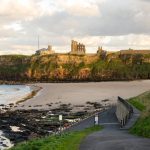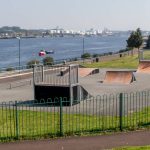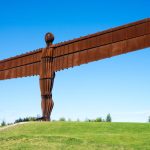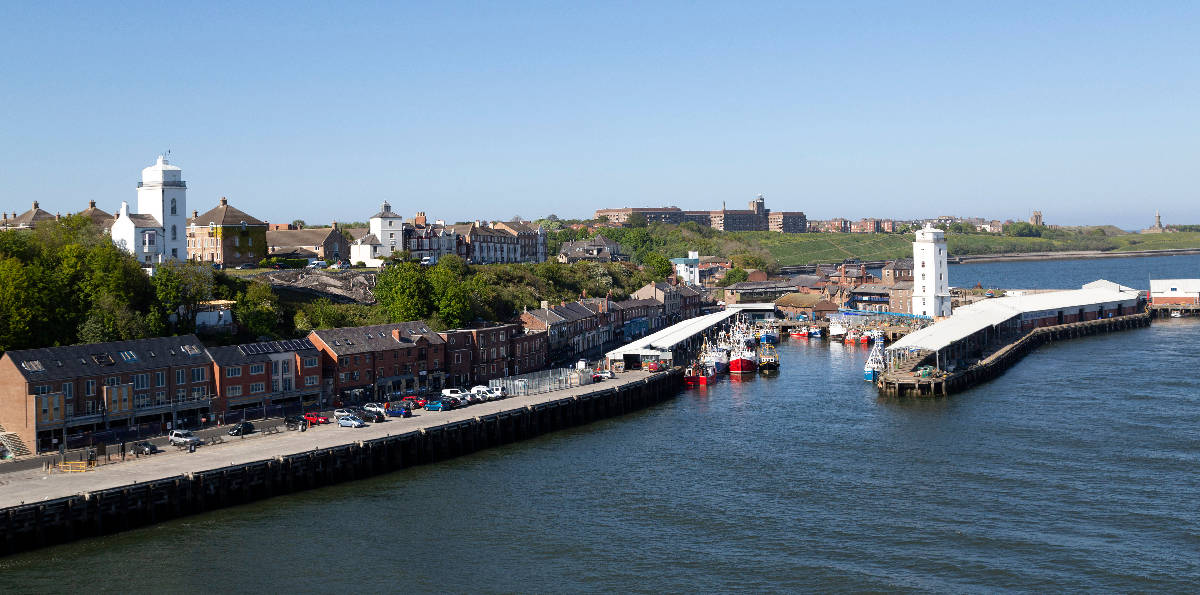
North Shields is a town on the north bank of the River Tyne in North East England, 8 miles north-east of Newcastle upon Tyne. Historically part of Northumberland, it’s now part of the metropolitan borough of North Tyneside. The town derives its name from the Anglo Saxon word ‘schele’, meaning a temporary shelter, such as a hut or shed. Its common in the region that people from North Shields, as with those from nearby Newcastle, are referred to as ‘Geordies’. At the 2011 UK census, the population of North Shields, i.e. those residing in the Tynemouth parliamentary wards of Riverside, Chirton and Howden, was recorded as 34,423.
North Shields – A Fleeting History
The first recorded settlement of any kind in what is now North Shields was in 1225, when the Prior of Tynemouth, Germanus, arranged for the erection of shelters for fishermen who were to provide fish for the Priory. These sheds or ‘shiels’ was situated on the headland close to the mouth of the River Tyne. As well as housing, a small wooden quayside was also built, where the fishing boats could land their catch. The quay was also used to ship coal from local collieries owned by the Priory. With work opportunities being plentiful, the population of the new settlement quickly reached 1000 strong.
However, the success of the now small port town was somewhat muted by the burgesses of Newcastle. The Burgesses, a clique of medieval businessmen, locally known as the Hostmen, believed themselves an entitlement to the custom rights for the whole of the River Tyne.
In 1290, the Hostmen successfully petitioned King Edward I, managing to get an embargo placed on North Shields, which forbid the loading or unloading of any cargo at the port. Despite the hold of the Burgesses remaining in place for more than the next 300 years, North Shields still managed to develop, initially based on its fishing industry and the export of locally produced salt.
North Shields Is Born
As time passed, ‘Shields’ gradually increased its active trading, such that by the end of the 14th century, the earlier royal prohibition order was now wilfully ignored. It was around this time that the town became known as ‘North Shields’ rather than ‘Shields’, to distinguish it from the other locally known ‘Shields’ which had developed on the south bank of the River Tyne.
By this time the town and port were thriving, driven to a degree by the export of coal, which continued to bring wealth to the Tynemouth Priory. In the early 1400s, the Newcastle Hostmen once again launched legal challenges against Tynemouth Priory for their supposed illegal trading through North Shields. However, the monks persevered and carried on regardless of the development of the port. In 1446, King Henry VI confirmed the trading rights of Tynemouth Priory for the Tyne, much to the anger of the local burgesses.
The long-held trading dispute between the two rival factions continued down the years. However, in 1530 things changed, and this time the law came down on the side of Newcastle, as it was decided that the Burgesses did after all have the right to control the trade on the Tyne. North Shields only managed to hold on to the right to produce salt and trade in fish and wine. The town subsequently went into decline as work opportunities disappeared, the population declined, rents began to fall, and the housing stock subsequently fell into disrepair.
The Plague Arrives
During the early part of the 17th century, things were worse for North Shields. In 1604, there was an outbreak of the plague (aka the ‘black plague’ or the ‘black death’), which desolated the town. However, the worst outbreak came in 1636, when the town’s filthy, poverty-stricken Sandhill area, was identified as the source of the disease that went on to kill almost half of the local population, and that of nearby Newcastle.
In the early 1700s, North Shields was still largely confined to a single street, which was built on a flat area of land, immediately adjacent to the river. This street stretched along the line of present-day Clive Street – Liddle Street – Bell Street. Other than that, there were only a few houses on the periphery of the town, clustered on the steeper terrain to the north. The town by this time was bustling but overcrowded and unsanitary. To escape the muck and grime, the town’s wealthy began to build houses on any available higher ground overlooking the old town. Dockray Square and Northumberland Square were two such developments. A series of steps were built to link the new housing areas to the old town area.
Coal Mining Takes Off
While coal mining in the North Shields area has been carried out on a relatively small scale since the end of the 13th century, it took off on a more industrial magnitude during the mid-18th century, becoming important to the local economy. During the 19th century, there were up to 7 deep pits in and around the town. The last working pit in the town was Chirton (aka Preston) Colliery which closed circa 1930.
Given its rich supply of experienced seamen, North Shields became a favoured hunting ground of the press gangs, the notorious recruiters for the Royal Navy. It was particularly notable towards the end of the 18th century, during the time of the French Wars, when the town along with South Shields, would regularly fall prey to raids by these gangs. The Press Gangs were greatly feared, as men were often unwillingly pressed into naval service on poor pay and conditions. Pressed recruits literally disappeared overnight, leaving their wives and family, more often than not, to rely on handouts from the local parish for survival.
Ship Building on the Tyne
In the 1780s, shipbuilding came to North Shields when Thomas Hearn set up his business at Low Lights building wooden ships. Other shipbuilding companies then followed, most notably William Smith & Co., who were in 1822, looking to expand their Byker based business, constructed a ballast quay at the town’s Limekiln shore. In 1851, North Shields most prolific shipbuilder, Smith & Co. opened its own dock, launching its first ship a year later.
In 1882, the company came under the control of Eustace Smith who began the company’s expansion at North Shields. In 1891, he renamed the company, Smiths Dock Company Ltd. Between 1839 and the end of the century, more than 130 ships had been built in the town. However, the first decade of the 20th century saw shipbuilding in North Shields peak, when more than 280 ships were built. In 1910, shipbuilding in the town came to an abrupt end, when Smith’s switched their shipbuilding operations to Middlesbrough, leaving North Shields downgraded to a repair yard.
In 1897, Stan Laurel, one half of the famous Hollywood duo Laurel and Hardy, moved to North Shields when he was 7 years old. He lived at No. 8 Dockwray Square until 1901.
During WW2, on 3 May 1941, disaster struck the town, when a single German bombing raid killed 105 people. A hundred and three people died, including many children, when a bomb struck the Wilkinson’s lemonade factory air-raid shelter. The other two people were killed at No.3 George Street.
North Shields – The Modern Era
By the 1960s North Shields proud history of shipbuilding was drawing to a close. In 1966, Swan Hunter and Wigham Richardson merged to form what would later become the Swan Hunter Group. They operated from Smith’s Docks and continued to carry out ship repairs up until its closure in 1987. Although occasionally used as a facility by the offshore oil industry the complex was derelict for many years
In 1989, a statue of Stan Laurel was erected in Dockwray Square as a reminder of the comic legend’s time spent there. The Square’s old Georgian houses in which had lived became derelict over time and were eventually demolished in 1956. They were replaced with the typically lacklustre tenement flats of the 1960s, which were replaced themselves in the 1980s, for more contemporary housing.
Following the demise of coal mining and shipbuilding in the area, several business parks, industrial estates and trading estates were established in the 1990s through various local government-backed regeneration programmes to provide alternative employment. The biggest of these is Silverlink and Cobalt, which is home to one of the UK’s biggest call centres.
In 2007, Smith’s Dockyard complex was acquired by the developer ‘Places for People’. In January 2015, they sought planning permission for the construction of homes on the site. The first of these homes were sold in 2017. The 2nd development phase ‘The Smokehouses’, architecturally inspired by the traditional smokehouses of the Fish Quay, was completed in autumn 2018.
Places to see in North Shields!
A couple of suggestions of things to see around North Shields are:
Tynemouth Priory and Castle
Tynemouth Priory and Castle overlooks the North Sea and the River Tyne, dominating the headland. With its 2000 years of history and spectacular views, it’s a great place to while away a few hours for those with an interest in history. The interactive ‘Life in the Stronghold’ exhibition tells the story of the site from its origins as an Anglo-Saxon settlement, and then through the Ages as an Anglican monastery, a royal castle, artillery fort and coastal defence.
Clifford’s Fort
Clifford’s Fort was constructed in 1672 for defensive purposes during the Anglo-Dutch wars. The fort was a gun battery and supplemented the defences at Tynemouth Castle. It was named after local MP and statesman, Lord Thomas Clifford. The walls of the old fort can still be seen, complete with ports and recesses for guns.
Things to do in North Shields!
Just a few of the things to do in and around North Shields would be:
Stephenson’s Railway Museum
Stephenson Railway Museum is a small heritage railway run by dedicated local volunteers. Trains run in season on Sundays, Bank Holidays, Thursdays during school holidays and weekends during December. An exhibition charts the story of Stephenson’s rise to fame through the development of the steam locomotive. There’s also a display of old steam and diesel engines.
Blue Reef Aquarium
There are over 40 displays of aquatic life from local waters to the more exotic. Amongst the more striking live exhibits are the blacktip reef sharks, which can grow to almost 2 metres in length. There’s also rays and other colourful fish that can be observed as you walk through the ocean tunnel.
Longsands Beach
If you like the sea, then Longsands Beach quite surprisingly has golden sand and the swimming is good. It’s now a popular surfing spot and has hosted the national surfing championships, the British Cup. It’s also possible to go canoeing, scuba diving and snorkelling. There’s a lifeguard cover from May to September.
North Pier
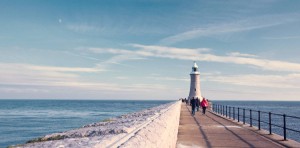
Image: Laura Donothey/Shutterstock.com
Any Visit to North Shields is incomplete until you have had a stroll along the pier. Wrap up warm though out of season as it does catch the wind!
Getting To North Shields
Road
If you’re travelling by car, then the easiest way to get to North Shields from London and the south, and Edinburgh and the east of Scotland, is via the A1. Just head for Newcastle from the south but turn onto the A194 at Washington, and then on to A19 following the road signs for Jarrow. After passing Jarrow and the Tyne Tunnel, turn right on the A1058 Coast Road, then drive straight for about 5 miles. You will find yourself about half a mile from the centre of North Shields. The A19 brings you north to the city from Sunderland, Middlesbrough and most of the Yorkshire area. The A1058 Coast Road, runs from Jesmond to Tynemouth on the east coast, while linking with North Shields, via the A19.
Rail
There is no mainline train station in North Shields. However, if you want to take the train to North Shields just head for Newcastle (see Newcastle guide for more information) Its train station is one of the busiest in the UK and connects directly to almost all the country’s major destinations. Newcastle’s Central Station is an interchange terminal for the Metro Line (See below). Thus, after arriving in Newcastle you can take the Metro directly to North Shields on the Yellow Line.
The Metro
Newcastle is served by the Tyne & Wear Metro, a system of suburban and underground railways covering much of the region. The Metro consists of two lines, the Green Line which originates at Newcastle Airport, passes through the city centre and then reaches Sunderland, terminating at South Hylton. The Yellow Line starts at St James, then runs eastwards north of the river to Whitley Bay, before returning to Newcastle, via North Shields on the coast.
Buses
The main operator that provides bus services in and around the North Shields itself is Arriva North East. Go North East runs buses locally from Newcastle & Gateshead to Whitley Bay passing through North Shields. Long-distance bus services to and from North Shields linking with the rest of the country is operated by National Express.
Airport
Newcastle International Airport on the outskirts of Newcastle at Ponteland is located approximately 15 miles (24 km) from North Shields. The town and the Airport are also linked via the Metro rail system. The expected journey time to/from North Shields to Newcastle Airport via car or taxi would be around 30 minutes and 50 minutes via the Metro. There are numerous short-haul and long-haul flights to multiple destinations throughout Europe, Asia and the Americas from Newcastle Airport.
Where to stay in North Shields?
A broad indication of prices for the most readily available types of accommodation in North Shields are:
Hotel: £80 – £120 (2 people sharing)
Lodge/B & B/Guesthouse: £40 – £80
Apartment/Holiday home: £80 – £120 (usually sleeping 2 – 6 people)
The Noth Shields Quiz
Quiz Maker – powered by Riddle
